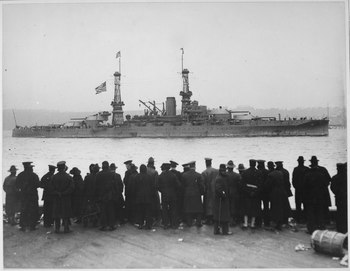Pennsylvania-class battleship

Arizona at the United States' post-First World War naval review in New York, December 1918
|
|
| Class overview | |
|---|---|
| Name: | Pennsylvania-class battleship |
| Builders: | Newport News and New York |
| Operators: |
|
| Preceded by: | Nevada class |
| Succeeded by: | New Mexico class |
| Cost: | $15,000,000 |
| Built: | 1912–1916 |
| In commission: | 1916–1946 |
| Completed: | 2 |
| Lost: | 1 |
| Retired: | 1 |
| General characteristics (as built) | |
| Type: | Dreadnought |
| Displacement: | |
| Length: | |
| Beam: | 97 ft 6 in (29.72 m) (waterline) |
| Draft: | 29 ft 3 in (8.9 m) (deep load) |
| Installed power: |
|
| Propulsion: |
|
| Speed: | 21.38 knots (39.60 km/h; 24.60 mph) (Pennsylvania's average on trials) |
| Range: | 6,070 nmi (11,240 km; 6,990 mi) at cruising speed of 12 knots (22 km/h; 14 mph) |
| Complement: | 55 officers and 860 men |
| Armament: |
|
| Armor: |
|
The Pennsylvania-class consisted of two super-dreadnought battleships built for the United States Navy just before the First World War. The ships were named Pennsylvania and Arizona, after the American states of the same names. They constituted the United States' second battleship design to adhere to the "all or nothing" armor scheme, and were the newest American capital ships when the United States entered the First World War.
The Nevada-class battleships represented a marked increase in the United States' dreadnought technology, and the Pennsylvania-class was intended to continue this with slight increases in the ships' capabilities, including two additional 14-inch (356 mm)/45 caliber guns and improved underwater protection. The class was the second standard type battleship class to join the US Navy, along with the preceding Nevada and the succeeding New Mexico, Tennessee and Colorado classes.
In service, the Pennsylvania-class saw limited use in the First World War, as a shortage of oil fuel in the United Kingdom meant that only the coal-burning ships of Battleship Division Nine were sent. Both were sent across the Atlantic to France after the war for the Paris Peace Conference of 1919, and were then transferred to the Pacific Fleet before being significantly modernized from 1929 to 1931. For the remainder of the inter-war period, the ships were used in exercises and fleet problems. Both Pennsylvania and Arizona were present during the Japanese attack on Pearl Harbor, which brought the United States into the Second World War. Arizona was sunk by a massive magazine explosion and was turned into a memorial after the war, while Pennsylvania, in dry dock at the time, received only minor damage. After a refit from October 1942 to February 1943, Pennsylvania went on to serve as a shore bombardment ship for most of the remainder of the war. Pennsylvania was present at the Battle of Surigao Strait, the last battle ever between battleships, but did not engage. Pennsylvania was severely damaged by a torpedo on 12 August 1945, two days before the cessation of hostilities. With minimal repairs, it was used in Operation Crossroads, part of the nuclear testing at Bikini Atoll, before being expended as a target ship in 1948.
...
Wikipedia
